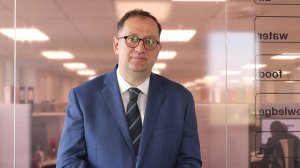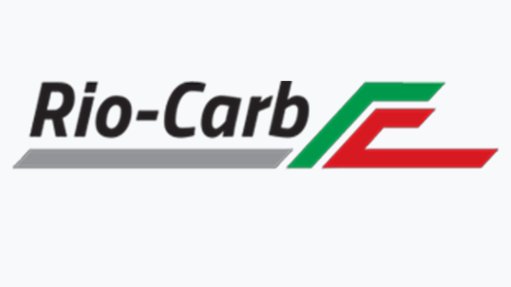Menar advancing on the manganese front

Menar MD Vuslat Bayoğlu interviewed by Mining Weekly's Martin Creamer. Video: Darlene Creamer.
JOHANNESBURG (miningweekly.com) – Private investment company Menar is advancing steadily on the manganese front.
The company's diversification into manganese began in 2021 with the East Manganese project in the Northern Cape, where a second manganese project is now at an advanced stage of assessment, and a manganese acquisition is under consideration.
In addition, Menar is also looking to develop manganese projects in Gabon.
The second manganese project is destined to be an underground operation, amid the maiden opencast East Manganese mine currently producing at a rate of 30 000 t a month of 36.5% manganese ore, which is crushed and dispatched to different customers.
“We decided to do our first bulk shipment out of Port Elizabeth and we did 55 000 t cargo recently, thanks to Transnet’s allocation,” Menar MD Vuslat Bayoğlu informed Mining Weekly in a Zoom interview. (Also watch attached Creamer Media video.)
Great for the manganese mining industry is the rise of manganese prices to the level of $5.36 per dry metric tonne unit. “But obviously there are still challenges on the railway side. We all want to move product to the ports but there are limitations,” said Bayoğlu.
Drilling at the second manganese project, on which a feasibility study was conducted, has been under way for the past two years to assess how the ore of this 50-million-ton deposit can be accessed.
Planned is the mining of the lower orebody seam, which has 36% or 37% manganese content. "Currently it looks feasible but obviously we must look at the future prices and developments in the manganese industry going forward. As we all know, the South African manganese industry will go underground at most of the mines, maybe in the next seven to ten years, so it’s important for us to keep this project in our portfolio and to develop it at the right time,” Bayoğlu explained.
Menar sees manganese as being important for its diversification strategy, with the company also looking beyond South Africa for iron-ore projects.
Menar's plan to soon develop manganese projects in Gabon follows the company's signing of a memorandum of understanding with the government of Gabon earlier this year.
MANGANESE AND NICKEL FOR BATTERIES
Battery manganese and nickel are the two commodities that Menar is looking to contribute to the energy landscape as part of its diversification strategy.
Being increasingly highlighted globally is the upcoming use of manganese in electric vehicles (EVs). Manganese is an alternative system for the batteries and Menar is hoping that its involvement in the manganese industry will contribute to the EV production space. The company's nickel asset in Türkiye is also critical for battery products for EVs and the development of that project is now also on the cards.
The project will create more nickel production capacity for the European market, given Türkiye’s proximity to it. To truck to Germany or a critical battery production area in Europe takes about three days.
Mining Weekly: What is the latest on your anthracite projects, particularly the new Mngeni shaft at Zululand Anthracite Colliery?
Bayoğlu: Anthracite is key for making steel, for making ferrochrome, ferrosilicon, and ferromanganese amongst other things. We have a very strong local and international customer base. We move products to Brazil, US, Vietnam, Ukraine. Most of these countries need the product for making metals and some of them need it for producing bulk power like in the case of Ukraine and Vietnam. Zululand Anthracite Colliery, or ZAC, is important for South Africa as it is the only producer of prime anthracite. We’re producing 8% ash product which is very important for Richards Bay Minerals, Glencore, Samancor, all companies keen on using our products. Hence a new investment for ZAC is crucial because we need to keep the mine operational and keep it viable cost-wise. Starting the Mngeni adit was vital for the life-of-mine at ZAC. We started it about 18 months ago and we got the first anthracite in April. We spent R150-million to develop the adit, which is going to produce 150 000 t of run-of-mine anthracite a year. We have other anthracite projects, which we are looking to develop, and these are at different stages of licensing. We see anthracite as a growth market for us and it is also part of our diversification strategy. Unlike thermal coal, it has a different market and different dynamics in terms of pricing, so we're looking to bring more anthracite projects into production.
Eskom seems to have turned a corner, could we possibly see the end of loadshedding in the near future?
We've surpassed the 50-day mark without power cuts and I think we're starting to see the benefits of filling positions with the right people. I think Eskom’s current CEO has a difficult job but so far, he's doing very well. We're getting the benefits of the maintenance programme as well. Unplanned breakdowns dropped by over 4 400 MW as of this month, which means we have more capacity available. The electricity availability factor went from 53% last year to 70%. These are all good developments. Eskom’s provision of baseload creates the opportunity for renewable energy producers because we need renewables as complementary to the baseload. Wind, solar and biomass will have a greater chance when Eskom has fixed loadshedding. I think Eskom is on the right track. Eskom’s performance data shows a reduction in unplanned breakdowns. Electricity Minister Kgosientso Ramokgopa mentioned that this is partly due to good performance from Eskom’s stations such as Kusile, Lethabo, Majuba, Matla and Medupi. But we also see improvements at Arnot, Camden, Hendrina as well as Grootvlei, which are the old power stations. I hope that they keep the momentum. The positive trend we're seeing will be good for the country and for investors, especially renewable-energy investors. Transnet has improved its performance in terms of rail volumes and revenue.
What more still needs to be done to ensure Transnet's full recovery?
Filling critical positions at Transnet and Transnet Freight Rail has helped to improve service delivery. Transnet Freight Rail ramped up coal trains from 21 trains a week to 28 trains a week as of this month, which is a great improvement. Transnet also reported overall improvement in revenue with a 12.8% year-on-year increase to R77.69-billion; and a 2.2% improvement in container handling. Despite these improvements, Transnet still has several issues to resolve, which includes the maintenance of infrastructure at the ports and rail tracks. The legislative reforms that have allowed the private sector to be more involved are critical to South Africa’s success. Without that, Transnet does not have enough funds to procure its own locomotives. They are sitting with a debt of about R13-billion and the private sector is interested in investing. What Transnet management has done in terms of reforms is positive. There'll be slots available for the private sector to move products to different ports, which will be critical for the industry because the other challenge Transnet faces is the availability of locomotives. I think they can resolve these issues with help from the private sector and that we can begin to see a stronger Transnet.
Article Enquiry
Email Article
Save Article
Feedback
To advertise email advertising@creamermedia.co.za or click here
Announcements
What's On
Subscribe to improve your user experience...
Option 1 (equivalent of R125 a month):
Receive a weekly copy of Creamer Media's Engineering News & Mining Weekly magazine
(print copy for those in South Africa and e-magazine for those outside of South Africa)
Receive daily email newsletters
Access to full search results
Access archive of magazine back copies
Access to Projects in Progress
Access to ONE Research Report of your choice in PDF format
Option 2 (equivalent of R375 a month):
All benefits from Option 1
PLUS
Access to Creamer Media's Research Channel Africa for ALL Research Reports, in PDF format, on various industrial and mining sectors
including Electricity; Water; Energy Transition; Hydrogen; Roads, Rail and Ports; Coal; Gold; Platinum; Battery Metals; etc.
Already a subscriber?
Forgotten your password?
Receive weekly copy of Creamer Media's Engineering News & Mining Weekly magazine (print copy for those in South Africa and e-magazine for those outside of South Africa)
➕
Recieve daily email newsletters
➕
Access to full search results
➕
Access archive of magazine back copies
➕
Access to Projects in Progress
➕
Access to ONE Research Report of your choice in PDF format
RESEARCH CHANNEL AFRICA
R4500 (equivalent of R375 a month)
SUBSCRIBEAll benefits from Option 1
➕
Access to Creamer Media's Research Channel Africa for ALL Research Reports on various industrial and mining sectors, in PDF format, including on:
Electricity
➕
Water
➕
Energy Transition
➕
Hydrogen
➕
Roads, Rail and Ports
➕
Coal
➕
Gold
➕
Platinum
➕
Battery Metals
➕
etc.
Receive all benefits from Option 1 or Option 2 delivered to numerous people at your company
➕
Multiple User names and Passwords for simultaneous log-ins
➕
Intranet integration access to all in your organisation

















